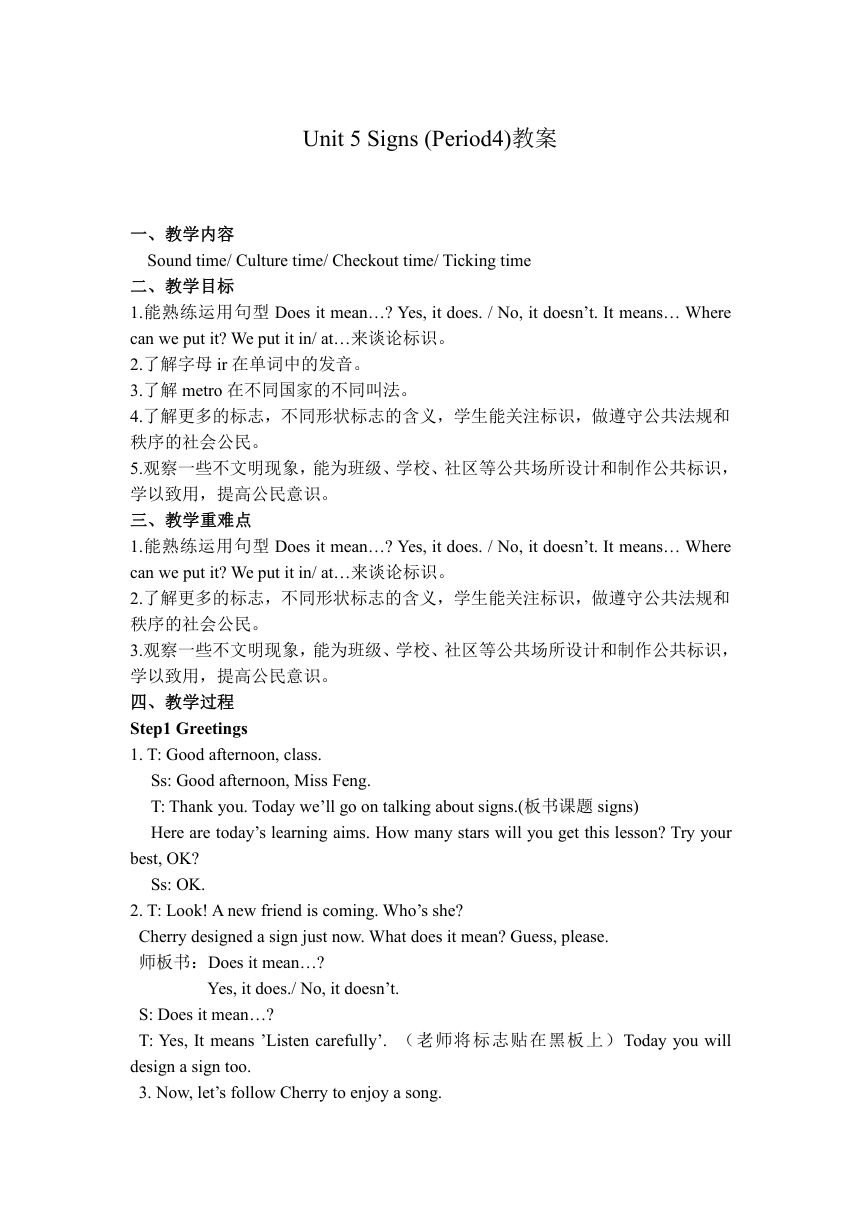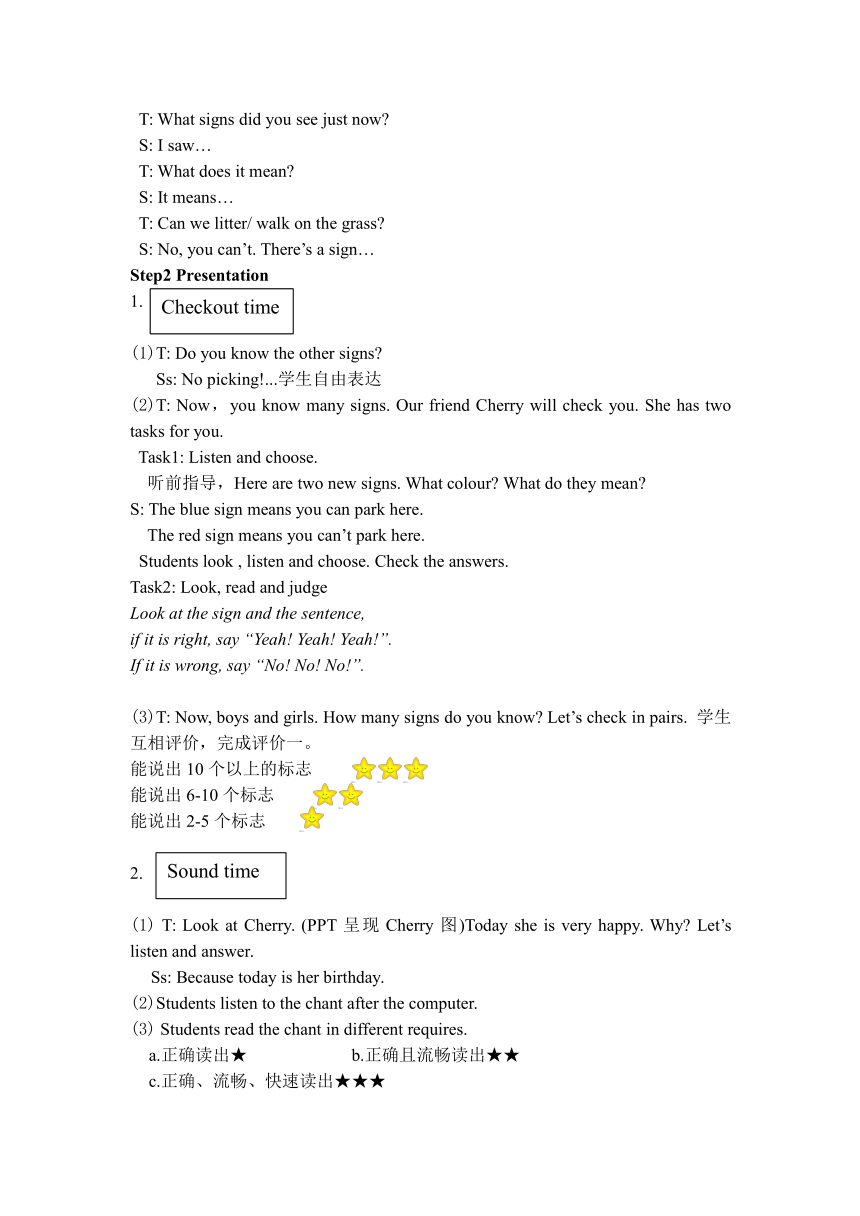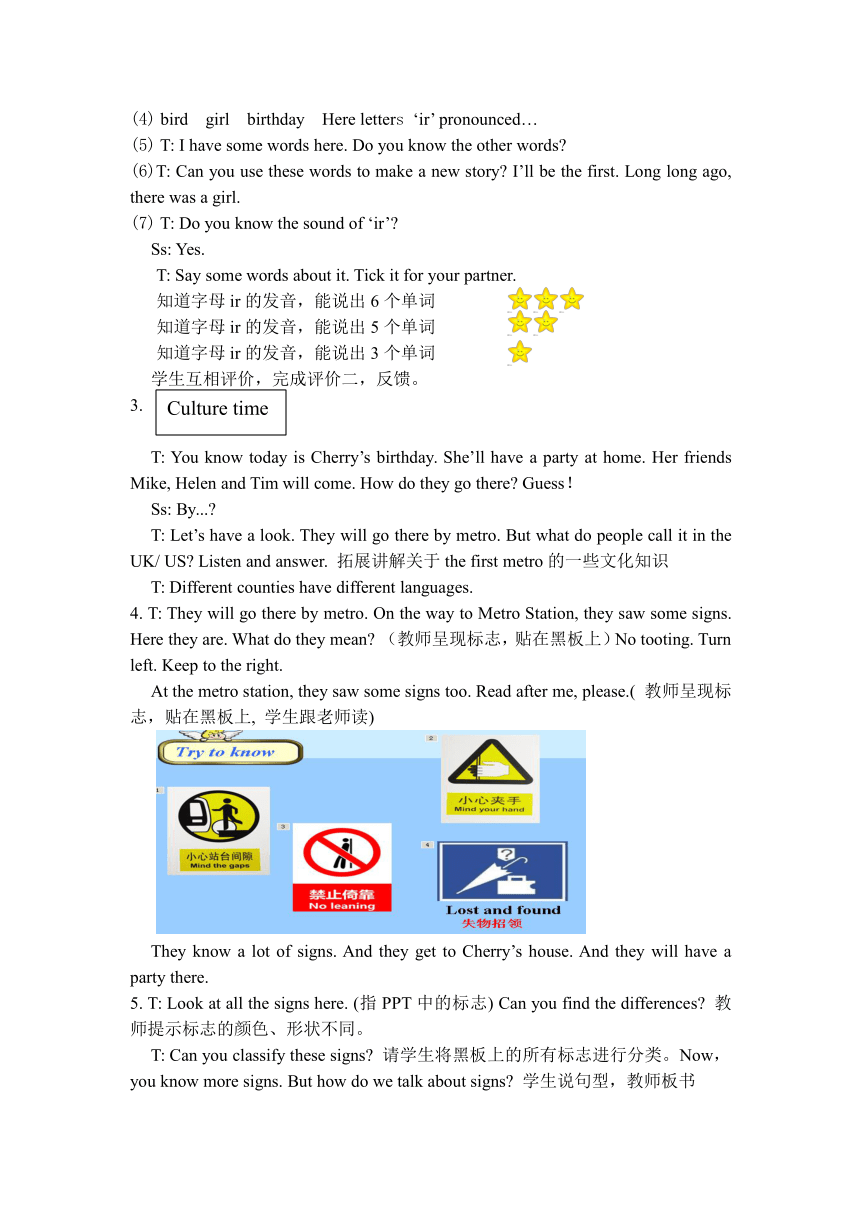Unit 5 Signs (Period4) 教案
文档属性
| 名称 | Unit 5 Signs (Period4) 教案 |  | |
| 格式 | docx | ||
| 文件大小 | 204.4KB | ||
| 资源类型 | 教案 | ||
| 版本资源 | 牛津译林版 | ||
| 科目 | 英语 | ||
| 更新时间 | 2021-12-20 08:29:58 | ||
图片预览



文档简介
Unit 5 Signs (Period4)教案
一、教学内容
Sound time/ Culture time/ Checkout time/ Ticking time
二、教学目标
1.能熟练运用句型Does it mean… Yes, it does. / No, it doesn’t. It means… Where can we put it We put it in/ at…来谈论标识。
2.了解字母ir在单词中的发音。
3.了解metro在不同国家的不同叫法。
4.了解更多的标志,不同形状标志的含义,学生能关注标识,做遵守公共法规和秩序的社会公民。
5.观察一些不文明现象,能为班级、学校、社区等公共场所设计和制作公共标识,学以致用,提高公民意识。
三、教学重难点
1.能熟练运用句型Does it mean… Yes, it does. / No, it doesn’t. It means… Where can we put it We put it in/ at…来谈论标识。
2.了解更多的标志,不同形状标志的含义,学生能关注标识,做遵守公共法规和秩序的社会公民。
3.观察一些不文明现象,能为班级、学校、社区等公共场所设计和制作公共标识,学以致用,提高公民意识。
四、教学过程
Step1 Greetings
1. T: Good afternoon, class.
Ss: Good afternoon, Miss Feng.
T: Thank you. Today we’ll go on talking about signs.(板书课题signs)
Here are today’s learning aims. How many stars will you get this lesson Try your best, OK
Ss: OK.
2. T: Look! A new friend is coming. Who’s she
Cherry designed a sign just now. What does it mean Guess, please.
师板书:Does it mean…
Yes, it does./ No, it doesn’t.
S: Does it mean…
T: Yes, It means ’Listen carefully’. (老师将标志贴在黑板上)Today you will design a sign too.
3. Now, let’s follow Cherry to enjoy a song.
T: What signs did you see just now
S: I saw…
T: What does it mean
S: It means…
T: Can we litter/ walk on the grass
S: No, you can’t. There’s a sign…
Step2 Presentation
1.
(1)T: Do you know the other signs
Ss: No picking!...学生自由表达
(2)T: Now,you know many signs. Our friend Cherry will check you. She has two tasks for you.
Task1: Listen and choose.
听前指导,Here are two new signs. What colour What do they mean
S: The blue sign means you can park here.
The red sign means you can’t park here.
Students look , listen and choose. Check the answers.
Task2: Look, read and judge
Look at the sign and the sentence,
if it is right, say “Yeah! Yeah! Yeah!”.
If it is wrong, say “No! No! No!”.
(3)T: Now, boys and girls. How many signs do you know Let’s check in pairs. 学生互相评价,完成评价一。
能说出10个以上的标志
能说出6-10个标志
能说出2-5个标志
2.
(1) T: Look at Cherry. (PPT呈现Cherry图)Today she is very happy. Why Let’s listen and answer.
Ss: Because today is her birthday.
(2)Students listen to the chant after the computer.
(3) Students read the chant in different requires.
a.正确读出★ b.正确且流畅读出★★
c.正确、流畅、快速读出★★★
(4) bird girl birthday Here letters ‘ir’ pronounced…
(5) T: I have some words here. Do you know the other words
(6)T: Can you use these words to make a new story I’ll be the first. Long long ago, there was a girl.
(7) T: Do you know the sound of ‘ir’
Ss: Yes.
T: Say some words about it. Tick it for your partner.
知道字母ir的发音,能说出6个单词
知道字母ir的发音,能说出5个单词
知道字母ir的发音,能说出3个单词
学生互相评价,完成评价二,反馈。
3.
T: You know today is Cherry’s birthday. She’ll have a party at home. Her friends Mike, Helen and Tim will come. How do they go there Guess!
Ss: By...
T: Let’s have a look. They will go there by metro. But what do people call it in the UK/ US Listen and answer. 拓展讲解关于the first metro的一些文化知识
T: Different counties have different languages.
4. T: They will go there by metro. On the way to Metro Station, they saw some signs. Here they are. What do they mean (教师呈现标志,贴在黑板上)No tooting. Turn left. Keep to the right.
At the metro station, they saw some signs too. Read after me, please.( 教师呈现标志,贴在黑板上, 学生跟老师读)
They know a lot of signs. And they get to Cherry’s house. And they will have a party there.
5. T: Look at all the signs here. (指PPT中的标志) Can you find the differences 教师提示标志的颜色、形状不同。
T: Can you classify these signs 请学生将黑板上的所有标志进行分类。Now,you know more signs. But how do we talk about signs 学生说句型,教师板书
6. T: Now, you know a lot about signs. I think you follow the signs. But some people don’t.(学生看图片,一些不文明行为)
7. T: Let’s enjoy some pictures. Let’s try to design a sign for public places. Talk about the sings with your partner.学生先完成设计的标志,然后四人小组介绍,再选学生上来展示设计的标志。(用黑板上的句子来进行介绍,可以适当丰富自己的话语)
能正确并流利谈论设计的标志
能正确较流利谈论设计的标志,有些错误
能谈论设计的标志,表达不流畅,错误较多,需努力
8. Read a poem
We need signs in our life.
Signs can tell us where to go and how to go.
Signs are like the policemen.
Signs can tell us
What to do and what not to do.
Signs are like our teachers.
Signs can tell us
What is dangerous and what is safe.
Signs are like our friends.
T: Signs are not big, but they are very useful. Follow the signs, be a civilized person.
Step3 Homework
1. Try to introduce your signs to your more friends or your family.
2. Surf the Internet and try to know more signs.
板书设计:
Signs
What How
Does it mean…
标志图 Yes, it does./ No, it doesn’t.
What does it/the/this/ that sign mean
It means…
Where can we see/ find / put it
We can see/ find/ put it …
五、教学反思
我校“体验英语”倡导以学生为中心,注重培养学生的自主性探究能力,并在这个过程中发展思维,体验成功。在课堂教学中,学生的提问能力是学生自主学习的一种积极表现,能主动挑起话题,并就话题进行有助于深入探讨的发问,这种发问控制着话题的方向和交谈内容,体现话语者的主观能动性。
本节课的内容有Sound time/ Culture time/ Checkout time/ Ticking time四个板块,内容较为松散,如何让本节课的内容有整体性并有吸引力?如何在课堂中激发学生的自主提问能力?下面将结合本节课,从我校魅力课堂的特质出发,谈谈培养学生提问能力的一些做法。
一、从文本内容出发,激发学生提问兴趣
兴趣是最好的老师。学生的提问兴趣除学生自身的内驱力外,有时还需要老师们去创设情境来培养。但这种情境的设置需从学生学的文本内容出发,如:本节课一开始,新朋友Cherry的到来营造了神秘的氛围,她今天设计了一个标识,是什么意思?学生们看着Cherry设计的标识,积极动脑思考并用Does it mean… 来进行提问,这样的提问是学生自主学习的一种表现。
再如:本节课中,当Cherry的朋友准备去她家参加生日Party,此时老师并没有直接告诉学生他们怎么去的,因为,交通方式的表达法学生五年级已经学过,这时,教师提问How do they go there Guess!让学生来猜一猜,这一活动既调动了课堂氛围,复习了旧知,同时也激发了学生的提问兴趣。
学生提出问题的过程实际上就是对教材掌握程度的具体体现,当学生发现并提出一个高质量问题时,必然伴随着分析综合、比较归纳、演绎推理等思维活动。
二、从学生生活出发,丰富学生提问的话语
教师在创设情境时一定要和学生身边的人和事紧密结合,紧贴生活,一定要让学生有话可说,从而丰富学生提问的话语。
本节课的最后,教师拓展介绍了一些学生生活中常见的而书本中未涉及到的标识,在此过程中,学生能积极用句子Does it mean… What does it/the/this/ that sign mean 自主提问了解相关标识的含义,并尝试进行分类,之后老师紧接着问How do we talk about signs ,启发学生思考并总结句子Does it mean… Yes, it does./ No, it doesn’t. What does it/the/this/ that sign mean It means…Where can we see/ find / put it We can see/ find/ put it …,这也是本单元学生要掌握的目标语。
学生学习语言的最终目的是能运用语言表达。本节课的拓展环节,为了激发学生的自主提问的能力,先让学生看了生活中一些不文明的图片,图片中人们的做法是学生在生活中见到的,容易引起学生的关注与共鸣。此项活动为之后的学生设计标识奠定了基础,学生们有所感、有所思、有所画。学生对各自设计的标识都很感兴趣,四人一组的“标识秀活动”丰富了学生提问的话语,学生们看着标识,谈论的问题很多,除板书上的内容外,学生还提出了:Why do you want to draw this sign 等问题。关注学生实际生活与文本生活的契合点是我校体验英语的特质之一。体验英语提出,学生情感的触发往往与一定的情境有关,情境是有效使用语言和话语,并评定是否恰当的重要根据。
培养学生的自主提问能力,教师需从文本内容和学生的实际生活出发,设计激发学生积极发问的情境是关键。学生用英语主动提问能力的培养方法,还与教师在学生提问过程中的角色、作用应该是密切关联的,诸如此类的问题还需在体验英语课程文化建设实施的过程中继续进行深度的研究。
一、教学内容
Sound time/ Culture time/ Checkout time/ Ticking time
二、教学目标
1.能熟练运用句型Does it mean… Yes, it does. / No, it doesn’t. It means… Where can we put it We put it in/ at…来谈论标识。
2.了解字母ir在单词中的发音。
3.了解metro在不同国家的不同叫法。
4.了解更多的标志,不同形状标志的含义,学生能关注标识,做遵守公共法规和秩序的社会公民。
5.观察一些不文明现象,能为班级、学校、社区等公共场所设计和制作公共标识,学以致用,提高公民意识。
三、教学重难点
1.能熟练运用句型Does it mean… Yes, it does. / No, it doesn’t. It means… Where can we put it We put it in/ at…来谈论标识。
2.了解更多的标志,不同形状标志的含义,学生能关注标识,做遵守公共法规和秩序的社会公民。
3.观察一些不文明现象,能为班级、学校、社区等公共场所设计和制作公共标识,学以致用,提高公民意识。
四、教学过程
Step1 Greetings
1. T: Good afternoon, class.
Ss: Good afternoon, Miss Feng.
T: Thank you. Today we’ll go on talking about signs.(板书课题signs)
Here are today’s learning aims. How many stars will you get this lesson Try your best, OK
Ss: OK.
2. T: Look! A new friend is coming. Who’s she
Cherry designed a sign just now. What does it mean Guess, please.
师板书:Does it mean…
Yes, it does./ No, it doesn’t.
S: Does it mean…
T: Yes, It means ’Listen carefully’. (老师将标志贴在黑板上)Today you will design a sign too.
3. Now, let’s follow Cherry to enjoy a song.
T: What signs did you see just now
S: I saw…
T: What does it mean
S: It means…
T: Can we litter/ walk on the grass
S: No, you can’t. There’s a sign…
Step2 Presentation
1.
(1)T: Do you know the other signs
Ss: No picking!...学生自由表达
(2)T: Now,you know many signs. Our friend Cherry will check you. She has two tasks for you.
Task1: Listen and choose.
听前指导,Here are two new signs. What colour What do they mean
S: The blue sign means you can park here.
The red sign means you can’t park here.
Students look , listen and choose. Check the answers.
Task2: Look, read and judge
Look at the sign and the sentence,
if it is right, say “Yeah! Yeah! Yeah!”.
If it is wrong, say “No! No! No!”.
(3)T: Now, boys and girls. How many signs do you know Let’s check in pairs. 学生互相评价,完成评价一。
能说出10个以上的标志
能说出6-10个标志
能说出2-5个标志
2.
(1) T: Look at Cherry. (PPT呈现Cherry图)Today she is very happy. Why Let’s listen and answer.
Ss: Because today is her birthday.
(2)Students listen to the chant after the computer.
(3) Students read the chant in different requires.
a.正确读出★ b.正确且流畅读出★★
c.正确、流畅、快速读出★★★
(4) bird girl birthday Here letters ‘ir’ pronounced…
(5) T: I have some words here. Do you know the other words
(6)T: Can you use these words to make a new story I’ll be the first. Long long ago, there was a girl.
(7) T: Do you know the sound of ‘ir’
Ss: Yes.
T: Say some words about it. Tick it for your partner.
知道字母ir的发音,能说出6个单词
知道字母ir的发音,能说出5个单词
知道字母ir的发音,能说出3个单词
学生互相评价,完成评价二,反馈。
3.
T: You know today is Cherry’s birthday. She’ll have a party at home. Her friends Mike, Helen and Tim will come. How do they go there Guess!
Ss: By...
T: Let’s have a look. They will go there by metro. But what do people call it in the UK/ US Listen and answer. 拓展讲解关于the first metro的一些文化知识
T: Different counties have different languages.
4. T: They will go there by metro. On the way to Metro Station, they saw some signs. Here they are. What do they mean (教师呈现标志,贴在黑板上)No tooting. Turn left. Keep to the right.
At the metro station, they saw some signs too. Read after me, please.( 教师呈现标志,贴在黑板上, 学生跟老师读)
They know a lot of signs. And they get to Cherry’s house. And they will have a party there.
5. T: Look at all the signs here. (指PPT中的标志) Can you find the differences 教师提示标志的颜色、形状不同。
T: Can you classify these signs 请学生将黑板上的所有标志进行分类。Now,you know more signs. But how do we talk about signs 学生说句型,教师板书
6. T: Now, you know a lot about signs. I think you follow the signs. But some people don’t.(学生看图片,一些不文明行为)
7. T: Let’s enjoy some pictures. Let’s try to design a sign for public places. Talk about the sings with your partner.学生先完成设计的标志,然后四人小组介绍,再选学生上来展示设计的标志。(用黑板上的句子来进行介绍,可以适当丰富自己的话语)
能正确并流利谈论设计的标志
能正确较流利谈论设计的标志,有些错误
能谈论设计的标志,表达不流畅,错误较多,需努力
8. Read a poem
We need signs in our life.
Signs can tell us where to go and how to go.
Signs are like the policemen.
Signs can tell us
What to do and what not to do.
Signs are like our teachers.
Signs can tell us
What is dangerous and what is safe.
Signs are like our friends.
T: Signs are not big, but they are very useful. Follow the signs, be a civilized person.
Step3 Homework
1. Try to introduce your signs to your more friends or your family.
2. Surf the Internet and try to know more signs.
板书设计:
Signs
What How
Does it mean…
标志图 Yes, it does./ No, it doesn’t.
What does it/the/this/ that sign mean
It means…
Where can we see/ find / put it
We can see/ find/ put it …
五、教学反思
我校“体验英语”倡导以学生为中心,注重培养学生的自主性探究能力,并在这个过程中发展思维,体验成功。在课堂教学中,学生的提问能力是学生自主学习的一种积极表现,能主动挑起话题,并就话题进行有助于深入探讨的发问,这种发问控制着话题的方向和交谈内容,体现话语者的主观能动性。
本节课的内容有Sound time/ Culture time/ Checkout time/ Ticking time四个板块,内容较为松散,如何让本节课的内容有整体性并有吸引力?如何在课堂中激发学生的自主提问能力?下面将结合本节课,从我校魅力课堂的特质出发,谈谈培养学生提问能力的一些做法。
一、从文本内容出发,激发学生提问兴趣
兴趣是最好的老师。学生的提问兴趣除学生自身的内驱力外,有时还需要老师们去创设情境来培养。但这种情境的设置需从学生学的文本内容出发,如:本节课一开始,新朋友Cherry的到来营造了神秘的氛围,她今天设计了一个标识,是什么意思?学生们看着Cherry设计的标识,积极动脑思考并用Does it mean… 来进行提问,这样的提问是学生自主学习的一种表现。
再如:本节课中,当Cherry的朋友准备去她家参加生日Party,此时老师并没有直接告诉学生他们怎么去的,因为,交通方式的表达法学生五年级已经学过,这时,教师提问How do they go there Guess!让学生来猜一猜,这一活动既调动了课堂氛围,复习了旧知,同时也激发了学生的提问兴趣。
学生提出问题的过程实际上就是对教材掌握程度的具体体现,当学生发现并提出一个高质量问题时,必然伴随着分析综合、比较归纳、演绎推理等思维活动。
二、从学生生活出发,丰富学生提问的话语
教师在创设情境时一定要和学生身边的人和事紧密结合,紧贴生活,一定要让学生有话可说,从而丰富学生提问的话语。
本节课的最后,教师拓展介绍了一些学生生活中常见的而书本中未涉及到的标识,在此过程中,学生能积极用句子Does it mean… What does it/the/this/ that sign mean 自主提问了解相关标识的含义,并尝试进行分类,之后老师紧接着问How do we talk about signs ,启发学生思考并总结句子Does it mean… Yes, it does./ No, it doesn’t. What does it/the/this/ that sign mean It means…Where can we see/ find / put it We can see/ find/ put it …,这也是本单元学生要掌握的目标语。
学生学习语言的最终目的是能运用语言表达。本节课的拓展环节,为了激发学生的自主提问的能力,先让学生看了生活中一些不文明的图片,图片中人们的做法是学生在生活中见到的,容易引起学生的关注与共鸣。此项活动为之后的学生设计标识奠定了基础,学生们有所感、有所思、有所画。学生对各自设计的标识都很感兴趣,四人一组的“标识秀活动”丰富了学生提问的话语,学生们看着标识,谈论的问题很多,除板书上的内容外,学生还提出了:Why do you want to draw this sign 等问题。关注学生实际生活与文本生活的契合点是我校体验英语的特质之一。体验英语提出,学生情感的触发往往与一定的情境有关,情境是有效使用语言和话语,并评定是否恰当的重要根据。
培养学生的自主提问能力,教师需从文本内容和学生的实际生活出发,设计激发学生积极发问的情境是关键。学生用英语主动提问能力的培养方法,还与教师在学生提问过程中的角色、作用应该是密切关联的,诸如此类的问题还需在体验英语课程文化建设实施的过程中继续进行深度的研究。
